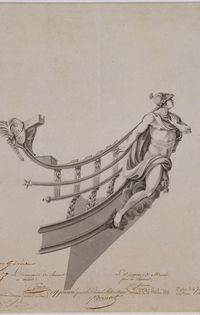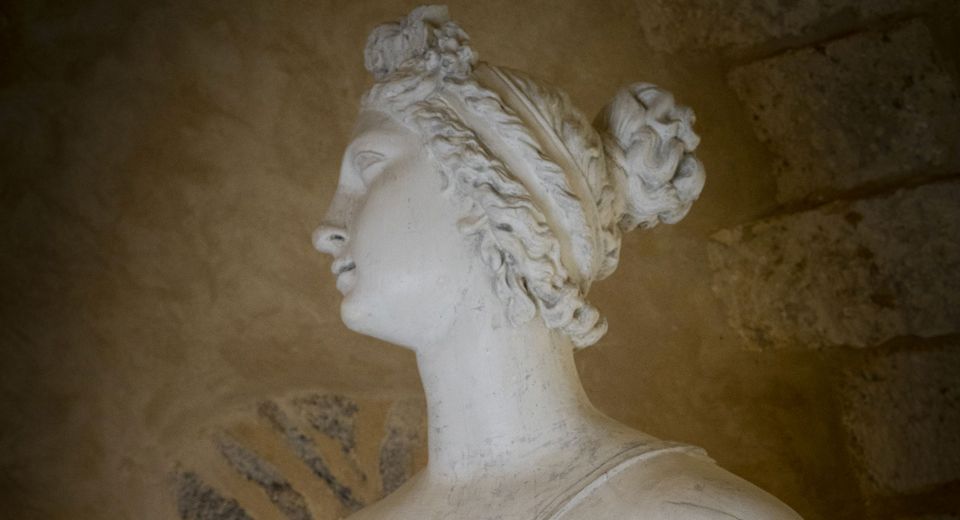Figurehead from the frigate Pandore
Brest
This bust of the Greek goddess Pandora decorated the prow of the frigate named after her. Since Colbert’s day, warships often had names borrowed from mythology. Although ships of the line were given such warlike names as Redoutable, Vengeur and Foudroyant, the smaller, faster and more elegant frigates were likened to women and baptised Hermione, Astrée, Flore, Néréide and so on.
The goddess Pandora
 Enlarge image : Figure de proue de la frégate Pandore
Enlarge image : Figure de proue de la frégate Pandore
In Greek mythology, Pandora was the first woman created by Zeus. Each god and goddess gave her one of their own attributes: Athena gave her cleverness, Aphrodite beauty, Apollo musical talent, Hermes the art of lying and curiosity, and Hera jealousy. Offered in marriage to Epimetheus, she joined her husband carrying a box with her that she was under no circumstances to open as it contained all the evils known to humanity. We all know what happened…
Logically enough, the figurehead shows the goddess with her box. The Pandore was a frigate whose keel was laid in Brest in 1829 and which was launched in 1835. The British Royal Navy also had a frigate of the same name, HMS Pandora, known for having been sent in search of HMS Bounty after the famous mutiny.
Naval decoration
 Enlarge image : Ornements de poupe de l'Orion
Enlarge image : Ornements de poupe de l'Orion
The late 17th century was the golden age of naval decoration in France, in Louis XIV’s reign. This art form was intended to “fanfare His Majesty’s magnificence on the seas”, which was why ornamentation of warships was mostly entrusted to artists from the Royal Court, starting with Charles Le Brun (1619-1683), First Painter to the King, and followed by Jean Bérain (1640-1711), who designed the King’s Bedchamber and went on to design the decorations for almost a hundred ships between 1685 and 1711. The designs created served a political ideology. They provided a narrative programme, usually of mythological inspiration and always connected with the vessel’s name, covering the entire surface to be sculpted: the stern, quarter galleries and prow.
During Louis XV’s reign, naval decoration was entirely decentralised in the Brest, Rochefort and Toulon shipyards. Their master sculptors became designers in their turn, no longer just simple implementers. In the 1780s, standardisation was the order of the day, both as regards the ship’s architecture and its decoration, whose utility was continually disputed. As a result, naval sculpture became a purely ornamental art. It only completely died out in the mid-19th century, with the disappearance of the last sailing warships and of all the shipyards’ sculpture workshops along with them.
Brest’s naval sculpture workshop
The sculpture workshop, which was located on the Penfeld’s left bank near the Recouvrance neighbourhood, beneath the Plateau des Capuchins, was directed by master sculptors, each holding the office of “First Master Sculptor”: Jean Regnault (1689-1697), Nicolas Renard (1697-1717), François-Charles Caffieri (1717-1729), Charles-Philippe Caffieri (1729-1766), Pierre Lubet (1766-1797) and Yves-Etienne Collet (1797-1840). When they were not working for the shipyard, sculptors and gilders fulfilled commissions from parishes and decorated local churches, their altarpieces in particular. As a result, the port of Brest became a centre for dissemination of baroque art in Brittany.
Yves-Étienne Collet was the last master sculptor to manage the Brest shipyard’s sculpture workshop, a post he occupied for over forty years. He started working at the shipyard when he was only 9 years old, under the protection of his father, the figurist sculptor Jacques-Étienne Collet (1721-1808). He left Brest and his father in 1777 to study at the Royal Academy of Sculpture in Paris. He spent his time there honing his skills, and seven years later, the Navy Council requested that he return to the Brest shipyards, where he ended his career at the age of 79.
Collection highlight
The essential works to see during your visit to the Musée national de la Marine in Brest, Port-Louis, Rochefort, Toulon, and soon in Paris.


